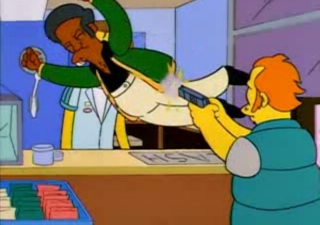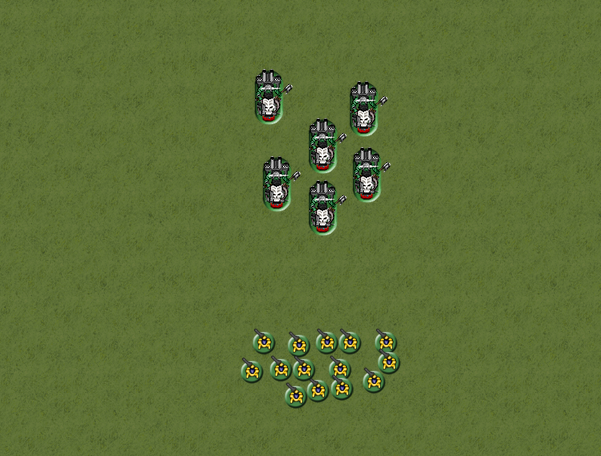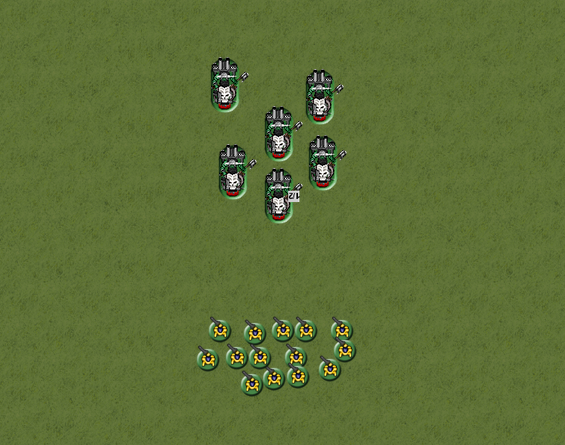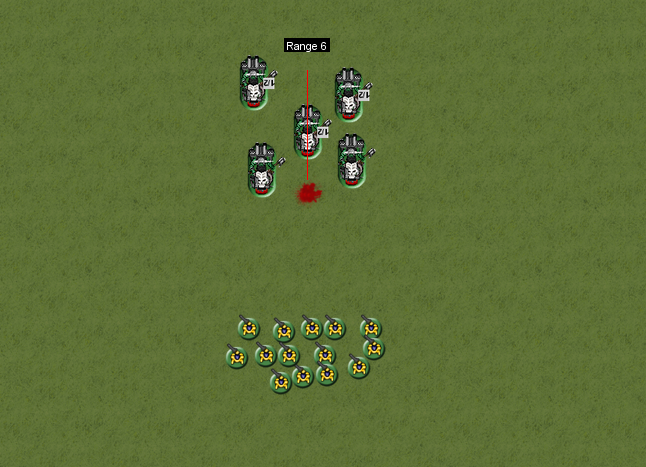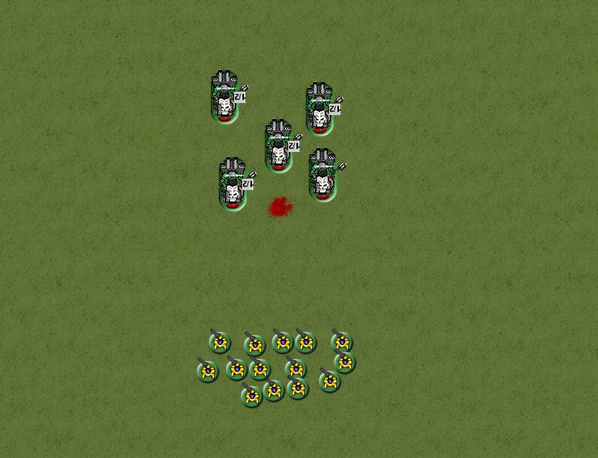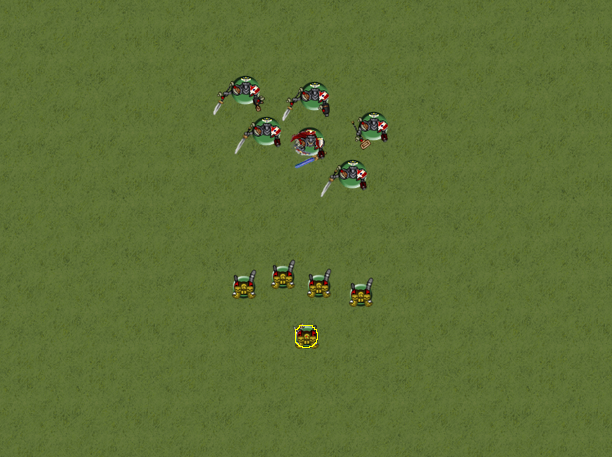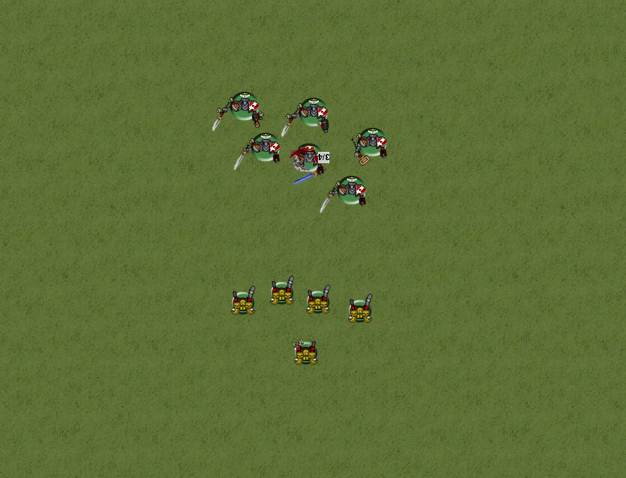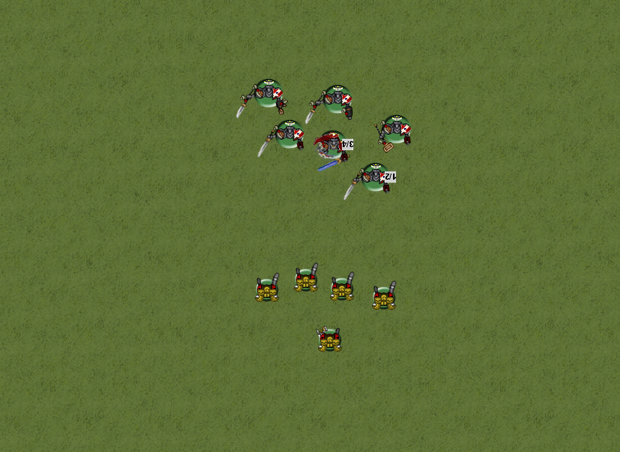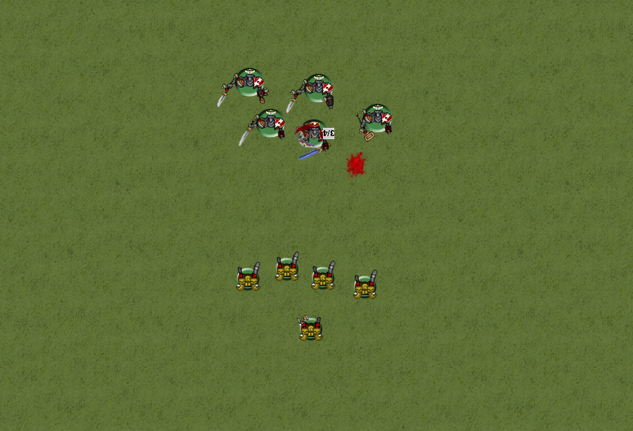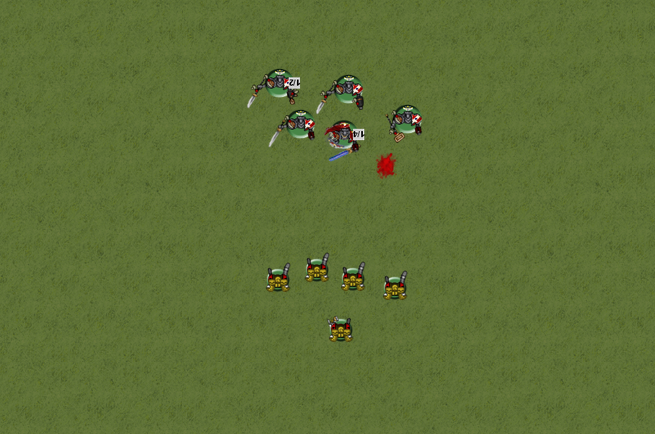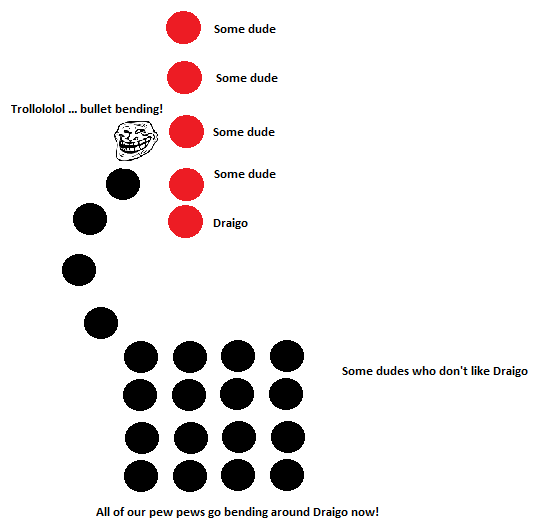40K: Look Out Sir! – Rules & Application

Look Out Sir is the new wound allocation but there seems to be a lot of confusion about it. Let’s break it down and then look at tactical applications.
Model removal is very different from 5th edition and model placement is now very important within a squad – something which was often overlooked (though still important) previously is now of the upmost importance. We’ve taken a very brief look at how this works and impacts regular play already and some more complicated situations over on 3++ but what still seems to get everyone in a pickle is Look Out Sir! (LoS! – the ! differentiates between Line of Sight and LoS!), particularly when combined with multiple-wound models. This posts clears the waters in this regard with some good old fashioned text and 2-D jpegs from Vassal (which is used only as a pictorial aide).
Look Out Sir!
Only models with the Character description can make these rolls. There seems to be a lot of confusion going around with this rule currently. It’s pretty simple when you break it down but as usual Games Workshop’s writing leaves something to be desired… Let’s look at the wording on pg 16.
“When a wound (or unsaved wound) is ALLOCATED to one of your characters, and there is another model from the same unit within 6″, he’s allowed a Look Out, Sir attempt.”
Emphasis mine. Allocated. Let’s go back to the TWO pg15 quotes to determine when allocation happens.Yes two because it happens at different stages depending how your unit is ordered.
pg15 – “…allocate an unsaved Wound to the enemy model closest to the firing unit. [] Continue allocating unsaved wounds to the closest model until there are no wounds left, or the whole unit has been removed…”
So this happens after all saves have been made. For example, a squad of 10 Space Marines takes 10 wounds. They all have the same armor save so the rolls are made all at once, no wounds have yet been allocated. They fail five saves so now unsaved wounds are being allocated. The Seargant is the fourth closest model in the squad to the firing unit so the first three Marines die. The Seargant now has a choice to LoS! the wounds allocated to him. He choose to LoS! the first which passes and ANY Marine with 6″ of the Seargant which is part of that squad may now take the unsaved wound instead. He choose to LoS! the second but fails and the Seargant dies. In the same example if he failed his first LoS! save, the Seargant would die and the fifth closest model to the firing unit would also die.
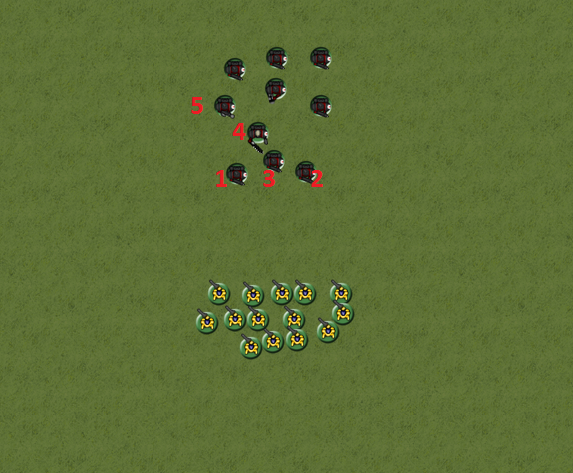 |
| Before |
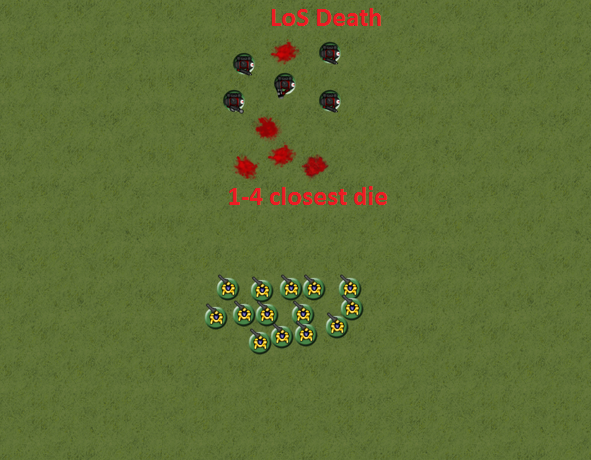 |
| Example 1 |
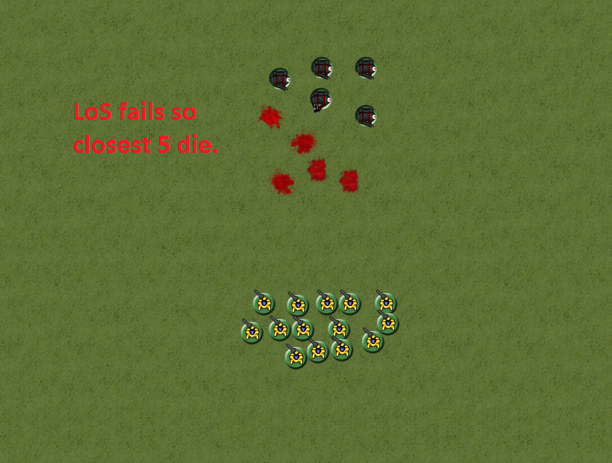 |
| Example 2 |
It gets more complex with mixed save units though so let’s refresh our memory on that rulebook quote.
pg 15 – “First, allocate a Wound from the Wound pool to the enemy model closest to the firing unit. The model gets to make a saving through []. If it fails, reduce that model’s wounds by 1. If the model is reduced to 0 Wounds, remove it as a casuality.”
Again, the important part here is allocation. Since the armor saves are different in such units each model (or group of models) is allocated wounds pre-save. If a character gets allocated any wounds at this point, he makes LoS! saves BEFORE he rolls his save. In essence, characters only get their actual saves if they fail LoS rolls or you choose not to take a LoS roll.
For example, a Wolf Guard attached to a Grey Hunter squad has a 2+ save from Terminator armor and is classified as a character and thus qualifies for a 4+ LoS roll. The squad takes six wounds where the Wolf Guard is the second closest model and has a different save. The dice are rolled one by one until the first Grey Hunter dies (let’s say this takes two dice so there are four wounds left to be allocated). The Wolf Guard has a choice to LoS each wound now allocated to him or he can take each save. He elects to take a save and rolls them one by one until there are two wounds left. He then elects to take a LoS roll which fails, so he must take another save which he passes. He elects to again take a LoS roll which passes and thus any Grey Hunter within 6″ and part of that squad may now take their normal save. The wound pool is now exhausted. What’s important here is you CANNOT use the better save of the Wolf Guard to tank saves until one fails and then LoS that one failed save to keep the Wolf Guard alive. LoS rolls are made at the time of ALLOCATION which becomes confusing due to allocation happening at different stages depending upon the unit make-up.
To clarify:
- if a unit is made up of all the same armor save, roll all your armor saves at once and being allocated unsaved wounds to the closest models. If such an unsaved wound reaches a character, they must take their LoS then or forego such an option. If it passes, continue making such rolls on the character until it fails enough to die or there are no more unsaved wounds.
- if a units is made up of different armor saves, allocate wounds as you would normally and then take saves. If such allocation reaches a character, they must take their LoS then (BEFORE they roll their own save) or forego such an option. If the character passes, continue making such rolls or their own armor save rolls, until the character is dead or there are no more wounds to be allocated.
Combined Look out Sir & Multiple wound models
Now to make it really confusing, let’s look at multiple wound models where Look Out Sir rolls can be made. This follows the same basic principles we should now all be familiar with, just a few more rolls have to be made. We’ll use examples to explain how these rules work in conjunction since there are no extra rules you need to know. We’ll take a unit of Nob Bikers who all get a 4+ LoS roll for being characters but all have the same armor save value. The unit takes twelve wounds and since they are all the same save, make them as a squad. They fail six saves and thus have six unsaved wounds. As each wound is allocated to a model, they may choose to make a LoS roll. This means the lead model can make all LoS rolls and if it gets a bit lucky and put those six wounds ANYWHERE within 6″ of itself in the squad. Let’s do this pictorally as we explain.
We need to allocate six unsaved wounds. The first Nob Biker is allocated the first wound and he elects to make an LoS roll. He fails and thus takes a wound.
The second, third and fourth LoS rolls he passes with some good luck and picks three different models on which to put the failed saves (remember, they’ve already been failed, it’s simply a matter of allocating the wounds now). He fails his 5th LoS roll however and thus dies.
There’s one more save to be made though and since the closest Nob Biker is unwounded, he simply takes the save leaving us with:
Only one Nob Biker dead but four wounded. The way this was described would take some time rolling dice but you can save time since they are all the same save if you apply cognitive thought. You can simply roll all the LoS saves at once – all which fail remove wounds/models from the front as you would normally and simply allocate the passed ones onto models within 6″ from those closest at the front. Now things can change depending how your LoS rolls go. In the above example since we had one wound leftover after our initial model took his LoS rolls, we simply didn’t make an LoS roll and took the wound on the chin since it was unwounded. Look at the situation and decide how many LoS rolls you want to roll in such a situation so you get the best mix of time and freedom of allocation whilst staying within the rules.
The next example will use a mixed save unit. We’ll be using Paladins and Draigo who have the same armor save but different invulnerable saves whilst still having multiple wounds. We are going to assume all shots being fire at them are S7 AP2 and thus will only impact the invulnerable save. The Honor Guard shoot with their plasma weapons and inflict eight S7 AP2 wounds. Because there are different (invulnerable) save values, wounds need to be allocated, saved, allocated, saved, etc. Look Out Sir rolls are done at the allocation stage but before saves are rolled.
The first model in line is a Paladin and since he only has a 5++ and Draigo has a 3++ with four wounds, the Paladin elects to make some LoS rolls. He has two wounds so we’ll roll these in batches of twos. He passes his first batch and elects to put each wound on Draigo who fails one.
There are six wounds left to allocate. The Paladin takes two more LoS rolls but fails both. He then takes his invulernable saves and passes one, leaving him on one wound but still being the closest model.
Since he only has one wound left (four left to allocate), we’ll only roll 1 by 1 now. He fails the first LoS roll and his invulernable save and thus dies. This leaves Draigo as the front man with a 2+ LoS roll due to being an independent character and three wounds left to save against.
He elects to LoS one wound to any Paladin within 6″ and part of the squad which passes. The Paladin fails his save and thus takes a wound. Draigo take the other wounds on the chin and thus rolls his 3++ and fails both and thus takes two more wounds which CANNOT be LoS’d as they have already been allocated.
The end result is Draigo took most of the wounds (and got unlucky) thus making the squad a bit more durable than before. If Draigo had been at the front he could have more reliably spread the wounds around (2+ LoS instead of 4+ LoS) and whenever they failed or he elected to take saves, was more likely to not fail thanks to his 3++.
Tactical Application
So you’ve got the rules down now (if not, keep reading above until you do). How then can this be applied on the tabletop? There’s two obvious answers here depending how the unit is made up.
First, characters with good armor saves make GREAT tanks. Secondly, characters in multi-wound units or character units with multiple wounds have a sort of wound allocation akin to 5th edition. Let’s be clear here though, this is not as good as it was before – now you’re relying on dice to allow you to transfer wounds, your units have to be a bit closer together to make sure everyone can LoS to each other and your opponent can move around 2+ LoS! characters, etc.
Let’s look at the first – tanking characters. Any character with a good save and good amounts of wounds is a great tank. And not just because of the obvious. The obvious is, a character often has better armor than the plebs of a squad and by sticking his chest out front, he can use that better armor save to protect the squad. When anything big comes along which can instant death him or bypass his save, he can LoS it to one of the plebs in the squad. This effectively gives the squad a better armor save from shots coming in from the front. It also ensures the squad is less likely to lose potential charge range distance by allowing members from the back of the squad to be picked off when necessary (through LoS! rolls). However, it also increases the chances of the character to be reduced to ash or simply become terribly inefficient in combat (i.e. 1 wound left) where they get challenged and die (or refuse and thus take no part in the fight). LoS! rolls aren’t a 100% guaranteed thing either, a 2+ is a 2+ but enough dice and that 2+ fails or enough dice on the character to roll saves and he’ll die as well.
Characters can also be used to tank hits in close combat assuming they are not involved in a challenge. Ensure they are in base to base and using the mixed armor rules, can take as many of the hits until they die or can use LoS! to allocate the wounds to members of the squad which are not going to become engaged (thereby saving attacks if the squad’s initiative step has yet to be reached). The Baron + Eldrad with a 2++ and 3++ respectively + Fortune could make a very potent combination here…if only they had a good combat unit as well (Banshees w/Mauls =D!).
Which brings us (somehow) to the 2nd point of mutli-wound character units and wound allocation. A character in these units will make all of this much, much easier, 2+ > 4+ after all. But the character nature of the squad also ensures if the character is bypassed, they still have LoS! options. This allows the unit to spread wounds as much as possible, much like in 5th edition and take wounds but maintain fighting effectiveness. Unlike 5th edition, this is MUCH less reliable unless there is a character around using his improved LoS! roll. There are often models you want to keep alive in a certain squad (i.e. Painboy, PK Nobz in a Nob Biker unit) and these will need to be kept at the back/centre of a squad – an enemy is going to be able to bypass a character at the front of the unit (unless they are a static gunline, i.e. bad army) or the character unit will fail enough LoS! rolls and then saves to kill off the front models. This reduces the effective threat range of the unit but ensures the key models are more likely to stay alive. Again, worse than 5th edition by a fair margin but allows such units to have some method of wound saturation.
Counter-Tactical Application
The most basic way to get around characters tanking for units is to move around the character. MVB did an amusing little diagram which I’ll post here...
This is an extreme example of 6th edition being uncimenatic (bending bullets) but the concept is the important part. All you have to do is make sure the unit shooting has a model closer to a model which isn’t the character, preferably closer to multiple models which are not the character. You don’t have to be this close either, move to the side or angles of units to ensure the character simply isn’t the closest model and you can bypass their tanking ability. Put a tank in front of the character so you cannot see the character. Woops, can’t shoot it now, have to shoot the unit. This is basically the opposite of sniping, you want to avoid the character. Against character units they still have the option of LoS! rolls back to the character but you’re forcing them onto a 4+ LoS! roll, much better than a 2+ and you’re more likely to damage the unit rather than the character itself. This is the goal.
This is harder in close combat if the character has a better save (and thus we are using mixed armor allocation rules). Even challenging isn’t going to stop this as if they are base to base contact, they remain there, they simply don’t get to attack or use their Leadership. The best way to defeat this then is during your movement phase. Use other units/vehicles to block the pile-in moves of the character or to completely push them out of the way (tank shocks). String your unit out so it’s less likely to engage the character during their pile-in moves (though be careful you don’t leave yourself vulnerable to being overwatched out of charge range) or move the unit so you’re charging from a different angle which keeps the character out of it. The important part here is to engage and defeat the unit in one round so the character doesn’t get multiple pile-in’s to begin tanking for the squad. Otherwise, you want to engage and keep engaging the unit forever with a much cheaper unit (i.e. fearless Orks, Termagants, etc.).
Use your noggin to get around the character tanking – if you throw yourself (or your shooting) straight at the unit, the character is doing what it was designed to do and unless you get lucky, you’re going to break your army on that rock and the rock will subsequently crush you. Tactics and thinking are what defeats the extreme versions of character tanking (aka deathstars).
Conclusion
What this means is yes characters (independent and non) can tank shots at the front and spread wounds amongst the squad (particularly multi-wound units). This gets around the closest to closest allocation rule but leaves the character more vulnerable. HOWEVER, characters must elect to do this at the appropriate moment which is ALLOCATION. This is defined as two different points depending upon the make-up of the unit’s armor save values. Characters are therefore much better at doing this when their save is different (hopefully better) from the squad’s as it gives more freedom of allocation to the controlling player. Beyond this, removing models and model placement is the exact same as discussed in previously. There are just a few more steps when multi-wound models and characters are brought into it.
When looking at characters tanking, there are a lot of benefits for it but it’s not entirely difficult to get around with a mobile shooting force. Thinking tactically should get around the character sticking his chest out at the front of the unit so you can reduce the unit’s effectiveness. Even if combat where this is harder, controlling your opponent’s movement with your own models is key to ensuring the character doesn’t suck up all your hits and laugh off your unit.
Kirby out. Understand now?

